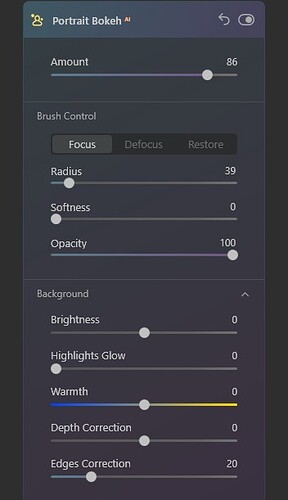Looks promising, Tony, thank you. Could you shortly describe the workflow. Or is it just a click? Dedicated parameters maybe? And do you share the impression that the farther away anithing is the more bokeh is applied?
It makes a mask. I was dubious if it would be clever enough to do two people but, as you see it is. With a group it gets into a muddle.
If the mask is OK all you need to do is to move a slider.
The slider controls the amount of bokeh. The controls like brightness effect the unmasked area. The brush focus you only need to use if the mask is wrong. I have been giving it more and more challenges and yes I can fool it with a really messy photo.
But the shots I showed are with a Ricoh GR and that has a ridiculous depth of focus even when fully open.
I’m now going to spend a bit of time reading the manual. From what I have found so far the controls we all use regularly on DxO such as exposure and white balance are available and work just as well. I guess where DxO is going to score more points is when we use ‘local adjustments’. But let me do some reading.
Artificial boke would look less artificial if the miniature effect could be used with a mask that eliminated the effect for the main subject(s). Bokeh comes as a gradient, therefore a LA with reduced microcontrast should do the trick, e.g. with the gardener and cruise images…
Is this an impression?
I think the bokeh of ViewPoint Tilt&shift is nicer than the local corrections blur.
There are interesting options to imitate the number of diaphragm lamelas.
FilmPack’s vignetting blur is ugly, but it’s for another purpose.
Pascal
Thanks for describing, Tony. I also watched some vids on Youtube. So on portraits it works very well but finally it masks areas and then blurs the unmasked areas to a increasing degree. Works fine but for other than portraits the masks must be made manually.
So, it can help in some cases and also has some interesting other features like sky exchange and easy but good portrait improvements a.s.o. but is not what I originally asked for:
“I wish there’d be a functionality which would be able to increase the unsharpness of areas in the picture which are alreaedy not perfectly sharp. This would allow to create a - sort of - fullframe look from smaller format cams such as APS-C or e.g. make a f2.8 shot look like a f1.4 one. The tools and APIs should already be available in the Software.”
I agree Luminar is not perfect. Like you I’d prefer DxO to create the mask automatically and do what you say.
But it is not a priority so I’ll ride the Luminar train until it is. I was planning to invest in FilmPack but still fail to see the benefit of all those film permutations. To me getting rid of oversharp backgrounds is more valuable.
